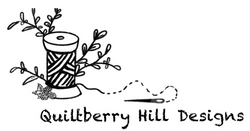Whenever I start a new design project, it usually includes one of two elements: a skill I want to improve or something I'm terrified of but eager to tackle. This month, I have the privilege of being the guest designer for the Sweet Potato Quilt Club. When brainstorming a block design that would resonate with Christina's membership, I immediately thought about her love for star blocks. But how could I make it unique and distinctly mine?
The answer came to me as I played around with layouts in Prequilt: I needed to add a circle. Not a drunkard's path, but a full circle -- one that could showcase a focal point if someone wanted to fussy cut fabric. However, I faced two challenges. First, I wasn't comfortable with inset circles and had barely attempted them. Second, Christina mentioned that her members weren't fans of curves.

Despite this, I reassured Christina that I'd include an alternative for the block center. Anyone who didn't want to attempt the circle could easily swap it for a square. Problem one solved. Now I had five months to master inset circles. No pressure!
To my surprise, it wasn't as daunting as I feared. Once I broke the process down and practiced, it became not just manageable but genuinely enjoyable. Tackling inset circles was incredibly satisfying, and I'm excited to share my biggest takeaways so you can embrace this skill too.
- The Math Is Simple
Calculating the size of your circles is one of the easiest steps in quilting.
- The inset circle should be 1 inch larger in diameter than the hole it's being added to. This accounts for the seam allowance on both pieces.
- Example: For a 3-inch circle in a 4-inch square, the starting circle size should be 3 1/2 inches, and the circle cut out from the square should be 2 1/2 inches. Once inset, the circle will finish at 3 inches.

2. Cutting Around Templates
There are many tools available for cutting circle such as the Creative Grids Circle Savvy Ruler. However since I was writing a pattern, I included a template to avoid requiring any additional purchases. I also had an acrylic template at home that matched my pattern's size.
While I preferred the acrylic template because its sturdy edge made cutting easier, the included template worked just as well. To strengthen it, I traced the template onto plastic for repeated use.

One trick I found helpful was marking the center of the template and folding the fabric into quarters. Aligning the folded corner (raw edges facing out) with the dot in the centre of the template. It will seem as though you are cutting only a quarter of a circle but when you unfold your fabric you will have a perfect circle. This not only gives you the shape you desire but prevents cutting at awkward angles.



3. To Pin or Not To Pin
To align my pieces, I first ironed equal folds into both the inner and out circles. While some quilters don't pin, that's not my style. However, the fiddly nature of aligning circles almost made me pull my hair out. Using my wool mat, I discovered I could pin the fabric directly to the mat for extra stability, which made the process more manageable.
Then I tried a happy medium: using a Sewline glue pen. By adding glue along the seam line and pressing it in place with a hot iron, I achieved a stable hold without the need for pins. This method made sewing much smoother and ensured nothing shifted out of place.





4. Go Slow
Quilting isn't a race. While deadlines can creep up on us, most of the time we quilt for the joy of it. Take your time when sewing around circles. Slowing down minimizes puckers and ensures a clean finish. When it works, the results are worth every extra moment.
5. Pressing Matters
Pressing direction can depend on your project. Initially, I pressed the seams outward, following the fabric's natural inclination. However, I noticed that my quarter-inch seam occasionally caught the circle's edge during block assembly. Pressing seams inward resolved this issue and created a cleaner, more polished finish.
6. You've Got This
Now that I've conquered my fear of inset circles, my imagination is bursting with new ideas for this technique. I can't wait to see how you use it too. Remember, with practice and patience, you'll be creating beautiful inset circles in no time!

This blog post contains affiliate links. This means that if you make a purchase I might make a small amount at no extra cost to you. This helps to support my small business. Thank you for being here.
